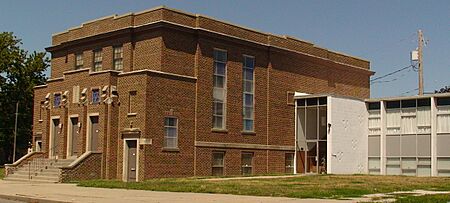B'nai Israel Synagogue (Council Bluffs, Iowa) facts for kids
Quick facts for kids B'nai Israel Synagogue |
|
|---|---|

B'nai Israel Synagogue, in 2012
|
|
| Religion | |
| Affiliation | Judaism |
| Rite |
|
| Ecclesiastical or organizational status | Synagogue and museum |
| Status | Active |
| Location | |
| Location | 618 Mynster Street, Council Bluffs, Iowa |
| Country | United States |
| Architecture | |
| Architect(s) | Jocheis Chris Jensen |
| Architectural type | Synagogue |
| Architectural style | Late 19th and early 20th century American Movements |
| Completed | January 11, 1931 |
The B'nai Israel Synagogue is a special Jewish place of worship located in Council Bluffs, Iowa, in the United States. It's also known as the Chevra B'nai Yisroel Synagogue, which was its first name. This historic building was added to the National Register of Historic Places in 2007 because of its importance.
Contents
The Story of B'nai Israel Synagogue
How the Jewish Community Started
The first Jewish group in Council Bluffs began in 1881. It was an Orthodox congregation called Bikur Cholim. They had 25 founding members. At first, they didn't have a rabbi or their own building. So, they held their services in places they rented.
Building Two Synagogues
A new group, the Chevra B'nai Yisroel Congregation, formed in 1903. It had 14 adult male members. They bought the land where the synagogue stands today. The group built their first wooden synagogue building there the next year.
Sadly, on March 5, 1930, a fire destroyed that building. But members of the congregation bravely saved important religious items. These included the Torah, which are sacred scrolls. After the fire, a committee was formed to plan a new synagogue. They chose architect J. Chris Jensen to design it. The old cornerstone from the first building was found. It was carved with a special message for the new synagogue. The new building was finished on January 11, 1931. It could seat 500 people.
Changes in Jewish Practice
In the 1950s and 1960s, the synagogue had several rabbis. The congregation continued to grow. Over time, they changed from Orthodox to Conservative Judaism. This meant some changes in their services. For example, English was used more often. Also, men and women could now sit together. Before, women and children sat separately in the balcony. The congregation officially changed its name to B'nai Israel in November 1953. In the early 1960s, an addition was planned to make the building bigger. Only the back part of this addition was built.
After the addition, the number of members started to go down. By 1980, there were talks about closing the congregation. But the members were determined to keep it going. They worked hard to find new members. In 1989, Rabbi Sharon Steifel became the first Reconstructionist rabbi at B'nai Israel. Other rabbis followed her.
B'nai Israel Today
In the 2000s, the synagogue no longer had a regular rabbi. It also stopped being officially connected to a specific Jewish movement. Today, they hold one service each month. People from Council Bluffs and even from Omaha attend these services. Many people who used to live in Council Bluffs still support the synagogue. They feel it's important for the community to keep going.
Synagogue Design
The outside of the synagogue is made of colorful, rough bricks. The top of the building has classical entablature and a metal cornice. The building sits on a raised basement. You reach the three main doors by walking up concrete steps. Above the doors, there are special panels. These panels show the Star of David and the Ten Commandments written in Hebrew.
Inside, the synagogue has two stories. There is a balcony, but its size was made smaller during a renovation in the 1960s. The congregation has seven Torah scrolls. Two of these were saved from the 1930 fire. The Ark, which is a special cabinet for the Torahs, is made of dark wood panels. It has classical pilasters, which are like flat columns. Doors with slats open to the cabinet where the sacred scrolls are kept.


